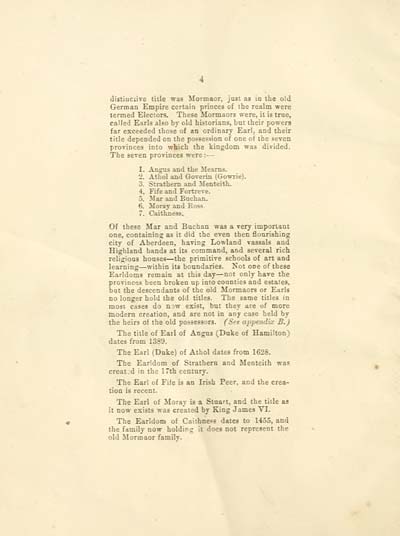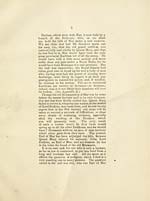Paper on the Mar peerage
(12) Page 4
Download files
Complete book:
Individual page:
Thumbnail gallery: Grid view | List view

distinctive title was Mormaor, jast as in the old
German Empire certain princes of the realm were
termed Electors. These Mormaors were, it is true,
called Earls also by old historians, bat their powers
far exceeded those of an ordinary Earl, and their
title depended on the possession of one of the seven
provinces into which the kingdom was divided.
The seven provinces were:--
1. Angus and the Jleams.
2. Athol and Goverin (Gowrie).
3. Stratbem and Menteith.
4. Fife and Fortreve.
5. Mar and Buchan.
6. Moray and B
7. Caithness,
Of these Mar and Bnchan was a very important
one, containing as it did the even then flourishing
city of Aberdeen, having Lowland vassals and
Highland bands at its command, and several rich
religions houses — the primitive schools of art and
learning— within its boundaries. Not ODe of these
Earldoms remain at this day — not only have the
provinces been broken up into counties and estates,
bat the descendants of the old Mormaors or Earls
no longer hold the old titles. The same titles in
most cases do now exist, but they are of more
modern creation, and are not in any case held by
the heirs of the old possessors. (See appendiy B. )
The title of Earl of Angus (Dake of Hamilton)
dates from 13S9.
The Earl (Duke) of Athol dates from 1628.
The Earldom of Strathern and Menteith was
creat.d in the 17th century.
The Earl of Fife is an Irish Peer, and the crea-
tion is recent.
The Earl of Moray is a Stnart, and the title as
it now exists was created by King James VI.
The Earldom of Caithne-s dates to 1455, and
the family now holding it does not represent the
old Mormaor familv.
German Empire certain princes of the realm were
termed Electors. These Mormaors were, it is true,
called Earls also by old historians, bat their powers
far exceeded those of an ordinary Earl, and their
title depended on the possession of one of the seven
provinces into which the kingdom was divided.
The seven provinces were:--
1. Angus and the Jleams.
2. Athol and Goverin (Gowrie).
3. Stratbem and Menteith.
4. Fife and Fortreve.
5. Mar and Buchan.
6. Moray and B
7. Caithness,
Of these Mar and Bnchan was a very important
one, containing as it did the even then flourishing
city of Aberdeen, having Lowland vassals and
Highland bands at its command, and several rich
religions houses — the primitive schools of art and
learning— within its boundaries. Not ODe of these
Earldoms remain at this day — not only have the
provinces been broken up into counties and estates,
bat the descendants of the old Mormaors or Earls
no longer hold the old titles. The same titles in
most cases do now exist, but they are of more
modern creation, and are not in any case held by
the heirs of the old possessors. (See appendiy B. )
The title of Earl of Angus (Dake of Hamilton)
dates from 13S9.
The Earl (Duke) of Athol dates from 1628.
The Earldom of Strathern and Menteith was
creat.d in the 17th century.
The Earl of Fife is an Irish Peer, and the crea-
tion is recent.
The Earl of Moray is a Stnart, and the title as
it now exists was created by King James VI.
The Earldom of Caithne-s dates to 1455, and
the family now holding it does not represent the
old Mormaor familv.
Set display mode to:
![]() Universal Viewer |
Universal Viewer | ![]() Mirador |
Large image | Transcription
Mirador |
Large image | Transcription
Images and transcriptions on this page, including medium image downloads, may be used under the Creative Commons Attribution 4.0 International Licence unless otherwise stated. ![]()
| Histories of Scottish families > Paper on the Mar peerage > (12) Page 4 |
|---|
| Permanent URL | https://digital.nls.uk/94943954 |
|---|
| Description | A selection of almost 400 printed items relating to the history of Scottish families, mostly dating from the 19th and early 20th centuries. Includes memoirs, genealogies and clan histories, with a few produced by emigrant families. The earliest family history goes back to AD 916. |
|---|
![[Page 3]](https://deriv.nls.uk/dcn4/9494/94943944.4.jpg)
